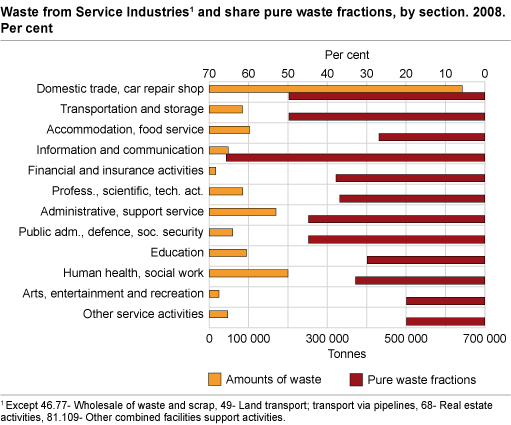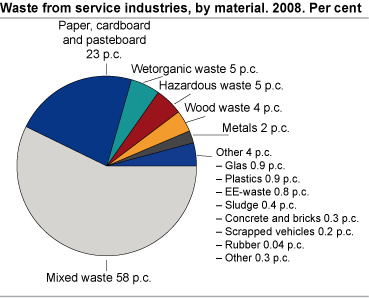Content
Published:
This is an archived release.
Waste increase in the service industries
The service industries disposed of almost 1.6 million tonnes of waste in 2008. This is 4 per cent more than in 2006. A total of 41 per cent of the waste had its origin in the domestic trade business. A large share of the waste, as much as 58 per cent, consisted of mixed waste.
More than 640 000 tonnes of waste came from the domestic trade business in 2008. This represents an increase of 7 per cent since 2006 for these industries. On average, each employee in the service industry contributed with 920 kg of waste in 2008. Since 2006, the increase has been 2 per cent. The amount of waste varies with type of activity. This means that the amount of waste generated per employee may differ between sections. While employees within domestic trade business were responsible for 1.9 tonnes, employees in financial intermediation contributed with less than 0.4 tonnes each in 2008.
Service industriesService industries is a collective term including wholesale and retail trade, hotels and restaurants, transport, storage and communication, financial intermediation, real estate, renting and business activities, together with public and personal services. This corresponds to section G-U in the Standard Industrial Classification (SIC2007) . For the time being, the statistics cover section G-S, except 46.77- wholesale of waste and scrap, 49- land transport; transport via pipelines, 68- real estate activities. |
Although as much as 76 per cent of the Norwegian workforce was employed in the service industries in 2006, only one fifth of the waste disposed in Norway came from these industries. The figures for 2006 have been edited since last publication (see the textbox “Uncertainty in the figures”).
More waste efficient
The waste amounts from the service industries have increased by 4 per cent since 2006.
In comparison, the value added for the industry increased by more than 11 per cent during these two years.
Most mixed waste
More than 900 000 tonnes, or 58 per cent, of waste was collected as mixed waste. In this context, mixed waste is defined as waste that cannot be classified as pure fractions.
For the waste fractions of metal, plastics and EE, there has been an increase since 2006. This increase can to some extent be attributed to enhanced sorting efforts by the industries. The increase is however uncertain due to a more extensive data acquisition, which generated a more substantial data basis for 2008 than for 2006. Thus, it cannot be definitely established that the waste fraction composition has in fact been altered during these two years.
New industry classificationA new version of the Norwegian industry classification (SIC2007) has been implemented from January 2009. The reclassification of publishing activities from manufacturing industry to the Service industries is the most important change. |
Uncertainty in the figuresThe calculations are based on customer registers from a selection of waste collectors. Some of the customers probably delivered a few pure waste fractions to waste collectors outside the selection, or to recipients outside the waste collection business. The total amount of waste and the amount of pure fractions may thus be too low, while the share of mixed waste may be too high. The 2006 figures have been recalculated. Hazardous waste and wrecked vehicles are now included. The 2006 figures are also adjusted to compensate for quality differences between the two data basis. Nevertheless, the uncertainty of the 2006 figures should be considered somewhat greater than the 2008 figures. |
Tables:
Contact
-
Camilla Skjerpen
E-mail: camilla.skjerpen@ssb.no
tel.: (+47) 48 22 72 14
-
Gisle Berge
E-mail: gisle.berge@ssb.no
tel.: (+47) 48 12 19 97


